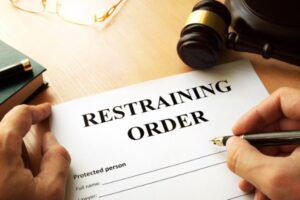
The only way to truly know if you can remove a restraining order placed against you is to talk with an attorney.
What Is a Restraining Order (Also Known as a Protective Order)?
A restraining order is a court order where a judge states that you cannot make any contact with the individual seeking protection. Contact includes in-person, text, telephone, email, or even trying to send messages through an intermediary. You may be ordered to stay so many feet away from their residence, place of employment, and the person in public.
These orders are issued in a variety of legal cases and for different reasons, including:
- Domestic abuse
- Sexual assault
- Child neglect and abuse
- Harassment
- Stalking
A restraining order may push you out of your own residence – even if it is in your name and you pay for it – when the order is issued to a spouse. Also, if you have children, these restraining orders can become problematic, removing you from your children’s lives and home. If the children are named in the restraining order, you cannot see them, while other times, the court may allow supervised visitation in the company of a neutral third-party.
The Issue with a Restraining Order – and Why You Get the Unfair Side of the Law
Restraining orders do not take much to issue, and it does not even require a trial. Instead, a restraining order can be taken out against you to manipulate a situation and even accuse you of things you did not do. There is no burden of proof standard for issuing these orders.
For example, you may have a spouse that is trying to gain an upper hand in divorce or child custody negotiations. With that order placed against you, you cannot get your belongings, visit your residence, or see your children until the order is lifted.
Despite Temptation, Never Violate a Restraining Order
Even if the order was placed against you in a situation like this, and you know that you are not a threat to anyone’s safety or life, do not violate the restraining order.
If you have a restraining order against you and you choose to violate it, you will face serious penalties. Even if the reasons that order is against you are unjust, you will not only face jail time, but you may pay court fines and serve probation, too. Each instance of contact may be charged as a separate violation – only making the penalties worse.
Even if the victim contacts you, you could be in violation of responding. Therefore, you should let your attorney know if the alleged victim is contacting you while there is an active restraining order in place.
How Do You Lift a Restraining Order?
Once the restraining order is activated, the victim or defendant has the right to request that the court lift that order. To do so, your attorney would need to file a motion with the court for a modification or to lift it entirely. Your attorney will identify all parties involved in the restraining order.
The Catch: The Victim Is a Deciding Factor
The victim has to agree to lift the order, and if they do, this will be mentioned in the motion and the process becomes much easier. If the victim contests that lift, then your attorney must list the reasons why the order should be lifted in the motion, arguing why there is no reason to maintain the order. Then, there will be an official hearing to discuss the restraining order, your reasons for asking for the lift, and the victim’s reasons for opposing it.
Both victim and defendant will testify, along with any witnesses, they feel necessary. Both attorneys can also cross-examine the victim and defendant to try and prove their case. Then, the judge will decide.
What Evidence Do You Need to Lift a Restraining Order?
In addition to testifying and the motion itself, your attorney will want to present evidence proving anything stated in the motion to lift that restraining order.
Some evidence that your attorney may present include:
- Documentation showing that you have completed any anger management or court-ordered rehabilitation that was the root cause of the restraining order.
- Statements by others that the restraining order is unnecessary or unwarranted.
- Evidence related to any child custody hearings or visitation guidelines and how the restraining order impacts them.
- Records from any probation officers, if you were convicted of a crime, and law enforcement personnel directly involved in the case.
- Any other evidence that can prove your good behavior.
The most important thing to remember is that you must show the court you are not a threat to the victim’s life or safety. You must show that the restraining order is causing you more harm than doing them good, and you need someone who can argue this on your behalf.
Hire a Defense Attorney Immediately
Whether you have a restraining order filed against you or someone has petitioned the court to get one, now is the time to act. A restraining order can impact your life, your relationships with family, and even force you to move out of your own home. You have the right to fight back against a restraining order and get your life back.
Contact the team at New Mexico Criminal Law Offices today. We know how unfair the courts can be about issuing these orders, and we have helped countless clients just like you present their case in court and successfully lift these restrictive orders.
Call us today to schedule a free consultation or contact us online to inquire about our legal services.

